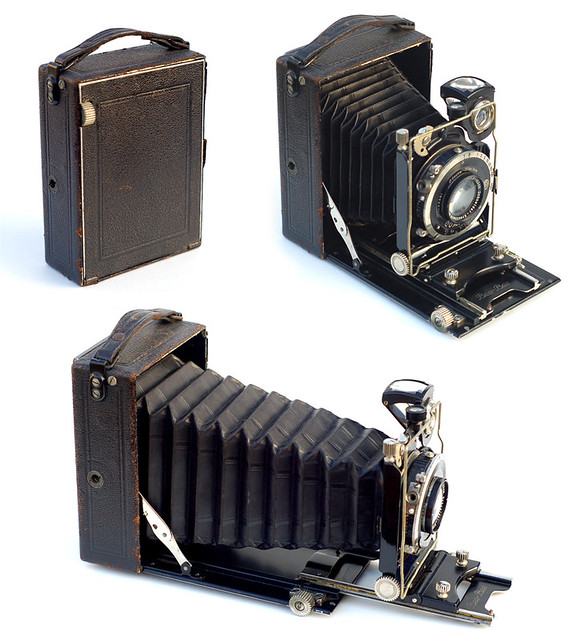Certotrop

|
| Bee Bee model A (the 6.5×9 cm Certotrop as marketed in the USA). image by John Kratz (Image rights) |
The Certotrop cameras are a series of folding plate cameras made by Certo in Dresden, Germany, from 1927 to '41.[1] The name would suggest a tropical camera; one made with materials resistant to the effects of heat and humidity on normal grades of wood, steel and leather, but it is not altogether clear that the Certotrop was intended to be a tropical model. The cameras are aluminium-bodied, under leather covering, and brown leather was an option for some versions of the camera[1]; specially-tanned brown or red-brown leather was commonly used for tropical cameras.
The camera is vertically oriented (i.e. built in 'portrait' format). It has a double-extension bellows, and rack-and-pinion focusing. It has front rise and (geared) shift. In addition to ground-glass focusing, there is a brilliant finder, with a spirit level attached, and a folding wire-frame finder.
The camera was made in three sizes, 6.5×9 cm, 9×12 cm and 10×15 cm.
The camera was redesigned in 1931. The most important change in specification was interchangeability of the lens and shutter, allowing the camera to be described as a 'special camera for easily-exchanged tele- and wide-angle lenses'.[2]
As is often the case with folding cameras, McKeown lists a very large range of lens and shutter options for each size. they include lenses by several makers, including a Meyer Trioplan, as used on many Certo cameras, Rodenstock Eurynar, Plaubel Anticomar and Supra-Anticomar, a Xenar or a Tessar. Shutters include the Ibsor and Compur. In part, the large number of lenses offered must reflect changes in the range over time. A late-1930s brochure lists fewer lenses:
- for the 6.5×9 camera, a 105 mm f/3 Trioplan, f/2.9 Xenar or a 105 mm f/3.5 Tessar.
- For the 9×12 camera, a 135 mm f/4.5 Xenar or 150 mm f/3.5 Xenar, or a 150 mm f/4.5 Tessar.
- For the 10×15 camera, a 165 mm f/4.5 Xenar or Tessar.
A note for the 6.5×9 camera says Cassetten zum Anlegen (i.e. plate-holders attach), and one for the two larger sizes says Cassetten zum Einschieben (plate-holders slide in).
Certotrop models were sold by Wallace Heaton in London under their Zodel brand. The 6.5×9 cm & 9×12 cm models were sold in the U.S. as the Bee Bee Model A (6.5×9 cm) and Model B (9×12 cm) by importer Burleigh Brooks (hence the name "Bee Bee").
Notes
- ↑ 1.0 1.1 McKeown, James M. and Joan C. McKeown's Price Guide to Antique and Classic Cameras, 12th Edition, 2005-2006. USA, Centennial Photo Service, 2004. ISBN 0-931838-40-1 (hardcover). ISBN 0-931838-41-X (softcover). p198.
- ↑ Late-1930s brochure 'Certo Cameras' describes the Certotrop as a Spezialcamera für Tele- und Weitwinkelobjektiv, da bequem auswechselbar.
Links
- 9×12 cm Certotrop with Meyer Satz-Plasmat lens set (a fixed rear lens with one or more exchangeable front components giving different focal lengths; see combinable lenses); sold at the 20th Westlicht Photographica Auction, on 12 November 2011. This camera has a 22 cm f/8 rear component and a 32 cm f/11 front component; used together, these give a more-or-less 'standard' lens for the format, of 15.3 cm and f/4.5; either component may be used on its own simply by unscrewing the other (the front one is most convenient to remove) so the set gives a standard lens and a choice of two long-focus lenses. There is a plate on the bed giving an infinity-focus mark for the rear lens alone ('H.L.'; hinterlinse), though the photograph showing this is no longer displayed in the listing.